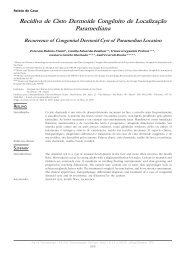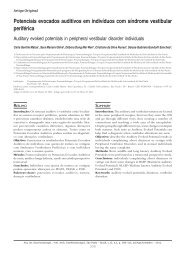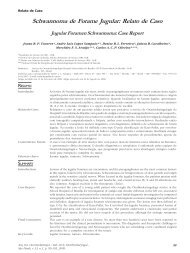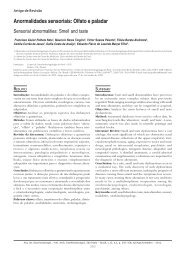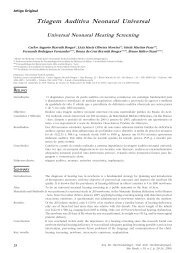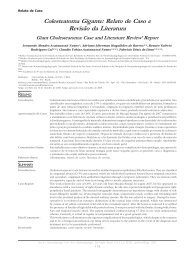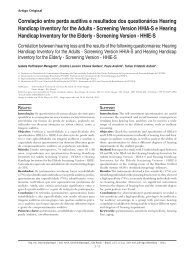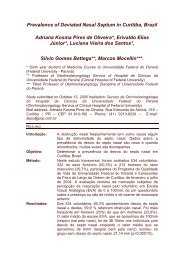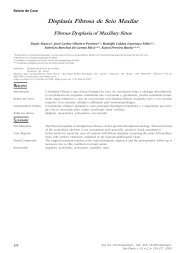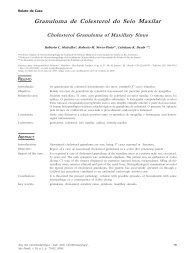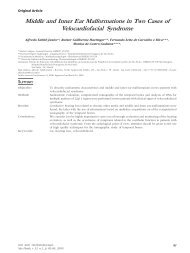Closure of Oroantral Communication Using Buccal Fat Pad Graft ...
Closure of Oroantral Communication Using Buccal Fat Pad Graft ...
Closure of Oroantral Communication Using Buccal Fat Pad Graft ...
Create successful ePaper yourself
Turn your PDF publications into a flip-book with our unique Google optimized e-Paper software.
Relato de Caso<strong>Closure</strong> <strong>of</strong> <strong>Oroantral</strong> <strong>Communication</strong> <strong>Using</strong> <strong>Buccal</strong> <strong>Fat</strong><strong>Pad</strong> <strong>Graft</strong> - Case ReportJosé Carlos Martins Junior*, Frederico Santos Keim**, Mariana Schmidt Kreibich**.* Oral and Maxill<strong>of</strong>acial Surgeon at Hospital Santa Catarina and Santo Antônio de Blumenau - SC. Medicine Student at Universidade Regional de Blumenau- FURB.** Medicine Student at Universidade Regional de Blumenau- FURB.Institution: Universidade Regional de Blumenau – FURBBlumenal / SC – Brazil.Mail address: José Carlos Martins Junior – Armando Odebrech 70, Sl. 1006 - Garcia- Blumenau / SC – Brazil - Zip code: 89020-400 – Telephone: (+55 47) 3322 4389– E-mail: j.c.martinsjr@bol.com.brArticle received on June 06, 2007. Article approved on October 12, 2007.SUMMARYIntroduction:Objective:Case Report:Conclusion:Keywords:There are many causes <strong>of</strong> fistulas that involve the nasal and antral cavities or both. They may resultfrom pathological entities or secondary to removal <strong>of</strong> tumors or maxillary cysts. However, the extraction<strong>of</strong> a maxillary molar or premolar is the most common cause <strong>of</strong> oroantral fistula. This is explained bythe close relationship between the apex <strong>of</strong> these teeth and the thinness <strong>of</strong> the antral floor. When theprimary fistula repair fails to heal spontaneously during the first three weeks after surgery, a secondaryrepair may be indicated. During treatment process <strong>of</strong> the fistulas, there are procedures to make a directclose or the use <strong>of</strong> a sliding mucosal flap, all techniques own an equal and high degree <strong>of</strong> failure.To show a case report <strong>of</strong> oroantral fistula and its closure.A 6-month-Surgical treatment <strong>of</strong> oroantral fistula, after a tooth removal, using the buccal fat pad methodas a pedicled graft associated with a sliding mucosal flap.The mentioned treatment is simple, complete and allows an extensive applicability in most <strong>of</strong> cases.oroantral fistula, orthodontic space closure, oral fistula, fistula.450Intl. Arch. Otorhinolaryngol.,São Paulo, v.12, n.3, p. 450-453, 2008.
Martins Junior JCINTRODUCTIONThe etiology <strong>of</strong> oroantral fistulas is very varied,among which we may point out pathologies whichaffect the maxillas, sequels <strong>of</strong> surgeries for tumor orcystic lesion removal and, the most frequent one, surgeryfor maxillary teeth extraction (pre-molar and molar).Several methods for the closing <strong>of</strong> such fistulas havebeen reported in the Medical literature, such as KILLEY &KEY’S in 1967, who demonstrated the slide-in flaptechnique through vestibular or palatine areas. However,this method is not always efficient in the treatment <strong>of</strong>such communications.An oroantral fistula which is smaller than 2 mmfrequently closes spontaneously. However, when thedefect is bigger or when there is inflammation, maxillarysinus or periodontal region infection, such fistula demandssurgical treatment for its complete closing (1).Picture 1. <strong>Buccal</strong>sinusal communication.The anatomy and vascularization <strong>of</strong> the buccal fatpad were investigated by TIDEMAN et al. in 1986, and wereclassically described as holder <strong>of</strong> four extents: buccal,pterygoid, and superficial temporal and deep temporal. Itsbody is the area with most facial surgical access.EGYEDI, in 1977, was the first one to report the use<strong>of</strong> buccal fat pad in a pedicellate way. And in 1983, NEDERreferred to the use <strong>of</strong> the buccal fat pad as free graft in 2patients in the construction <strong>of</strong> oral defects which hadartificially been created. A study presented by TIDEMAN etal in 1986 about the use <strong>of</strong> pedicellate graft with the buccalfat pad to correct buccal and maxillary defects concludedthat such grafts present good results.Consequently, we aim at reporting a clinical case <strong>of</strong>secondary closing <strong>of</strong> oroantral fistula through the technique<strong>of</strong> buccal fat pad as pedicellate graft associated to mucousgraft.CASE REPORT47-year-old male leukodermatous patient, referredto the oral and maxill<strong>of</strong>acial attention at the multiplespecialtyclinic in Blumenau-SC complaining <strong>of</strong> pain on theleft hemiface and <strong>of</strong> persistence <strong>of</strong> non-healed orifice dueto a superior tooth extraction six months before. At theclinical examination, a fistula in alveolar border <strong>of</strong> leftmaxilla was observed, with communication with themaxillary sinus and pus drainage after orifice pumping witha curette. The X-ray revealed left maxillary sinus veilingwith fault in its floor (Pictures 1 and 2), leading it to thechronic sinusitis diagnosis.Picture 2. Panoramic X-ray which shows bone defect.Antibiotics and anti-inflammatory medication havebeen used to control the infection and to a further closingsurgery through the use <strong>of</strong> buccal fat pad technique. After7 days using the medication, the patient underwent a newevaluation, when he presented no symptoms and no pusdrainage in the fistula.The closing surgery happened under generalanesthesia through nasal-tracheal intubation. The approachhas been started with infiltration <strong>of</strong> vasoconstrictor solution(adrenaline 1/90,000) in and area adjacent to the perforationand at the bottom <strong>of</strong> the left maxillary groove. The borders<strong>of</strong> the fistula were subperiostally incised in wedge withsuperior extension in vestibular floor up to the insertedIntl. Arch. Otorhinolaryngol.,São Paulo, v.12, n.3, p. 450-453, 2008.451
Martins Junior JCPicture 3. <strong>Buccal</strong> fat pad gripping.Picture 4. <strong>Buccal</strong> fat pad exposition.Picture 5. Final aspect <strong>of</strong> the fistula closing.Picture 6. Image after 30 days.mucosa. The posterior-superior elevation was done with aFreer elevator, close to the maxillary wall until the buccalfat pad was found. At this moment, a mild suction wasstarted with aspirator beak, which enables the fat elevationup to the oral cavity. The buccal fat pad was gently stuckby tweezers and gripped up to the fault (Picture 3 and 4)After the complete covering <strong>of</strong> the bone defect, thefat was stitched to the adjacent mucosa with plain catgut3.0 suture. At this moment, a supra-periostal longitudinalincision aiming at the hard palate was done, elevated androtated to cover the buccal fat pad, and then stitched to thealveolar mucosa vestibular to the defect (plain catgut 3.0).After the surgery, the patient was medicated and guided tonot do intra-oral negative pressure and to cease using hisdenture for thirty days. The post-surgical phase has nocomplications, and a mild loss <strong>of</strong> vestibular groove depthwas observed, but did not prevent him from using hisdenture (Picture 5 and 6).DISCUSSIONThe primary closing <strong>of</strong> oro-antral fistulas in 48 hourspresents a 90 to 95% success rate, and such rate falls to 67%when the closing is secondary (5,6). The latter is still aproblem with difficult solution. It is essential that thesinusitis is treated first. Several authors demonstrated thata three-day exposure <strong>of</strong> the maxillary sinus presents apathology through radiographic evidence (7,8).452Intl. Arch. Otorhinolaryngol.,São Paulo, v.12, n.3, p. 450-453, 2008.
Martins Junior JCThe buccal fat pad may be used to close oro-antralcommunications once its success has been proved in themedical literature and because it does not interfere thevestibular groove depth. Due to its anatomical position, ithas beneficial characteristics to be used as pedicellate graftto reconstruct intra-oral defects, specially in the posteriorregion <strong>of</strong> the maxilla.CONCLUSIONThe treatment <strong>of</strong> oro-antral communications throughthe use <strong>of</strong> buccal fat pad is a simple and complete method,which enables several uses in most <strong>of</strong> the cases. The bloodsupply <strong>of</strong> the buccal fat pad is not affected due to itsdisplacement, once it is gripped and replaced between theflap and the maxillary wall. The operated case had nocomplications and the chronic sinusitis was cured.BIBLIOGRAPHIC REFERENCE1. Hanazawa Y, Itoh K, Mabashi T, Sato K. <strong>Closure</strong> <strong>of</strong> oroantralcommunications usig a pedicled buccal fat pad graft.J oral Maxill<strong>of</strong> Surg. 1995, 53:771-775.2. Tideman H, Bosanquet A, Scott J. Use <strong>of</strong> the buccal fatpad as a pedicled graft. J oral Maxill<strong>of</strong>ac Surg. 1986, 44:435-440.3. Egyedi P. Utilization <strong>of</strong> the buccal fat pad for closure <strong>of</strong>orao-antral and/or oro-nasal communications. J Maxill<strong>of</strong>acSurg. 1977, 5:241.4. Neder A. Use <strong>of</strong> buccal fat pad for grafts. Oral Surg. 1983,55:349.5. Eppley B, Scfar<strong>of</strong>f A. Oro-nasal fistula secondary tomaxillary argumentation. Int Oral Surg. 1984, 13:535.6. Stajcic Z. The buccal fat pad in the closure <strong>of</strong> oro-antralcommunications - A study <strong>of</strong> 56 cases. J Craniomaxill<strong>of</strong>acSurg. 1992, 20:193.7. Ericson S, Finne K, Persson G. A clinical - radiographicreview <strong>of</strong> treated oro-antral communications. Int J Oral Surj.1973, 2:185.8. Haanaes H R, Pedersen K N. Treatment <strong>of</strong> oroantralcommunication. Int J Oral Surg. 1974, 3:124.Intl. Arch. Otorhinolaryngol.,São Paulo, v.12, n.3, p. 450-453, 2008.453



